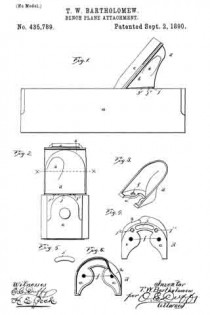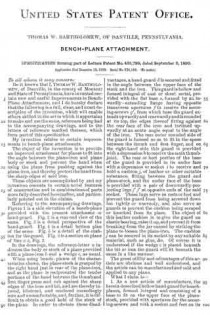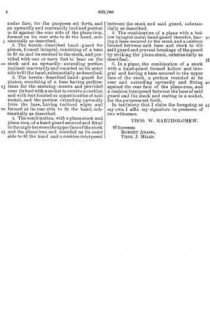No. 435,789 – Bench-Plane Attachment (Thomas W. Bartholomew) (1890)

UNITED STATES PATENT OFFICE.
_________________
THOMAS W. BARTHOLOMEW, OF DANVILLE, PENNSYLVANIA.
BENCH-PLANE ATTACHMENT.
_________________
SPECIFICATION forming part of Letters Patent No. 435,789, dated September 2, 1890.
Application filed December 18, 1889. Serial No. 334,188. (No model.)
_________________
To all whom it may concern:
Be it ltnown that I, THOMAS W. BARTHOLOMEW, of Danville, in the county of Montour and State of Pennsylvania, have invented certain new and useful Improvements in Bench-Plane Attachments; and I do hereby declare that the following is a full, clear, and exact description of the invention, which will enable others skilled in the art to which it appertains to make and use the same, reference being had to the accompanying drawings, and to the letters of reference rnarked thereon, which form part of this specification.
My invention relates to certain improvements in bench-plane attachments.
The object of the invention is to provide an improved attachment for planes to fit into the angle between the plane-iron and plane body or stock and prevent the hand when using the plane from pushing against the plane-iron, and thereby protect the hand from the sharp edges of said iron.
These objects are accomplished by and my invention consists in certain novel features of construction and in combinations of parts more fully described hereinafter, and particularly pointed out in the claims.
Referring to the accompanying drawings, Figure 1 is a side elevation of a bench-plane provided with the present attachment or hand-guard. Fig. 2 is a rear view of the same. Fig. 3 is a detail perspective of the hand-guard. Fig. 4 is a detail bottom plan of the same. Fig. 5 is a detail of the cushion for the guard. Fig. 6 is a section on plane of line x x, Fig. 2.
In the drawings, the reference-letter a indicates the body or stock of a plane provided with a plane-iron b and a wedge c, as usual.
When using bench-planes of the characteristics shown, the plane-stock is grasped by the right hand just in rear of the plane-iron, and as the plane is reciprocated the tender portions of the hand between the thulnb and first linger press and rub against the sharp edges of the iron and bit, and are thereby injured, blistered, and rendered exceedingly sore and uncomfortable, and, further, it is difficult to obtain a good hold of the stock of the plane. In order to obviate these disadvantages, a hand-guard d is secured and fitted in the angle between the upper face of the stock and the iron. This guard is hollow and formed integral of cast or sheet metal, provided with the fiat base e, formed by an inwardly-extending flange having opposite transverse apertures f to receive the securing-screws g’, from which base the guard extends upwardly and rearwardly and is rounded at its top, the edges thereof fitting against the rear face of the iron and inclined upwardly at an acute angle equal to the angle of the iron. The rear outer rounded side of the guard is formed so as to fit in the space between the thumb and first linger, and on the right-hand side this guard is provided with a depression It to receive the main thumb-joint. The rear or heel portion of the base of the guard is provided in its under face with a depression or socket i to receive and hold a cushion j, of leather or other suitable substance, fitting between the guard and plane-stock, and the under face of the base is provided with a pair of downwardly-projecting lugs j’ j’ at opposite ends of the said socket. These lugs serve as rests or feet and prevent the guard from being screwed down too tightly or unevenly, and also serve as guards to prevent the cushion being scraped or knocked from its place. The object of this leather cushion is to give the guard an elastic bearing, raise it up, and prevent it from breaking from the jar caused by striking the plane to loosen the plane-iron. The cushion j can be secured in its socket by any suitable material, such as glue, &c. Of course it is understood if the wedge c is placed beneath the bit or iron the guard will iit beneath the same in a like manner.
The great utility and advantages of this article are obvious and well understood, and the article can be manufactured and sold and applied to any plane.
What I claim is —
1. As a new article of manufacture, the herein-described hollow hand-guard for bench-planes, formed integral and consisting of a base to fit on the upper face of the plane-stock, provided with apertures for the securing-screws and with a socket and feet on its under face, for the purposes set forth, and an upwardly and rearwardly inclined portion to fit against the rear side of the plane-iron, formed on its rear side to iit the hand, substantially as described.
2. The herein-described hand-guard for planes, formed integral, consisting of a base to fit on and be secured to the stock, and provided with one or more feet to bear on the stock and an upwardly-extending portion inclined rearwardly and rounded on its outer side to fit the hand, substantially as described.
3. The herein-described hand-guard for planes, consisting of a base having perforations for the securing-screws and provided near its heel with a socket to receive a cushion and with feet located on opposite sides of said socket, and the portion extending upwardly from the base, having inclined edges and formed at its rear side to fit the hand, substantially as described.
4. The combination, with a plane-stock and plane-iron, of a hand-guard secured and fitted in the angle between the upper face of the stock and the plane-iron and rounded on its outer side to fit the hand and a cushion interposed between the stock and said guard, substantially as described.
5. The combination of a plane with a hollow integral metal hand-guard therefor, having a base secured to the stock and a cushion located between said base and stock to tilt said guard and prevent breakage of the guard by striking the plane-stock, substantially as described.
6. In a plane, the combination of a stock with a hand-guard formed hollow and integral and having a base secured to the upper face of the stock, a portion rounded at its rear and extending upwardly and fitting against the rear face of the plane-iron, and a cushion interposed between the base of said guard and the stock and resting in a socket, for the purposes set forth.
In testimony that I claim the foregoing as my own I affix my signature in presence of two witnesses.
THOS. W. BARTHOLOMEW.
Witnesses:
ROBERT ADAMS,
THOS. J. MILES.



